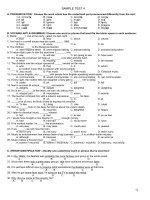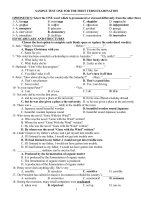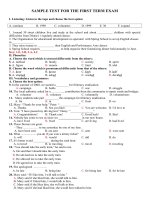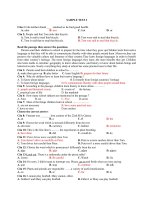Sample test HPIII
Bạn đang xem bản rút gọn của tài liệu. Xem và tải ngay bản đầy đủ của tài liệu tại đây (63.13 KB, 7 trang )
SAMPLE TEST
I.
Choose the correct word to complete the sentences
- Vocabulary:
1. ………… is a chronic disease of lung.
A. Asthma
B. Pneumonia
C. Sore throat
D. Emphysema
2. ………… is an infection of the lungs caused by fungi, bacteria, or
virus.
A. Asthma
B. Pneumonia
C. Sore throat
D. Emphysema
3. Emphysema makes it difficult for the patient to …………
A. inhale
B. exhale
C. breathe in
D. eat
4. The ………… are the main organs of the respiratory system.
A. bronchial tubes
B. pulmonary artery
C. lungs
D. trachea
5. ………… is a condition where the appendix becomes inflamed.
A. gingivitis
B. iritis
C. sore throat
D. appendicitis
6. ………… is a medical procedure which examines the inside of the
colon.
A. endoscopy
B. colonoscopy
C. abdominal endoscopy
D. gastroscopy
7. Stomach is a pouch-like organ between the ………… and small
intestine.
A. large intestine
B. colon
C. esophagus
D. rectum
8. The doctor need to ………… the victim’s condition.
A. assess
B. estimate
C. examine
D. check
9. It is advisable for us to apply ………… on the injury to stop bleeding.
A. examination
B. pressure
C. bandage
D. drug
10. The nurse used ………… to close the open wound.
A. bandage
B. needle
C. stiches
D. drug
11. ………… a unit of mass equal to one millionth of a gram.
A. mg
B. mcg
C. g
D. milliliter
12. ………… a unit of mass equal to one thousandth of a gram.
A. mg
B. mcg
C. g
D. milliliter
13. ………… is a kind of cotton fabric used to cover wounds or surgical
incisions.
A. bandage
B. gown
C. bedpans
D. gauze
14. They are ordering a(n) ………… to help for Mrs. Jones’ back pain
A. pressure mattress
B. oxygen tank
C. gown
D. bedpan
15. Please take this sample to ………… for testing.
A. radiology
B. pathology
C. pharmacy
D. dermatology
16. ………… is a doctor who provides many kinds of care to adults and
children.
A. Pediatrician
B. Geriatrician
C. General practitioner
D. Obstetrician
17. ………… is a doctor who renders patients unconscious or prevents
them from feeling pain.
A. Anesthesiologist
B. Geriatrician
C. General practitioner
D. Obstetrician
18. The ………… system carries oxygen in blood to all part of the body.
A. respiratory
B. digestive
C. circulatory
D. cardiology
19. ………… is a blood vessel that carries blood away from the heart.
A. vena
B. capillary
C. artery
D. vein
20. ………… the smallest kind of blood vessel in the body.
A. vena
B. capillary
C. artery
D. vein
- Grammar:
21. The artist had qualified as a doctor but later ………… the practice of
medicine for painting the picture of people.
A. gave up
B. giving up
C. given up
D. give up
22. This is Mrs. White, whose invention ………… hundreds of deaf
people already.
A. will help
B. helping
C. has helped
D. help
23. The hospital ………… by a famous cardiologist in 1993
A. was founded
B. has been founded
C. were founded
D. had been founded
24. It was a great success. He succeeded ………… every patient laugh.
A. to make
B. in make
C. for making
D. in making
25. He enjoys his work as a baker but it has taken him over three years to
………… working.
A. used
B. get used to
C. being used to D. getting used
26. Many people nowadays have to wear false teeth ………… they are
middle-aged.
A. unless
B. while
C. because of
D. when
27. His eyes were ………… bad that he couldn’t read the number plate
of the car in front.
A. such
B. too
C. so
D. very
28. He was said ………… this building.
A. designing B. to have designed
C. to design
D. designed
29. David feels ………… again after his illness but he still cannot work
………… .
A. strong/ hard
B. strong/hardly
C. strongly/hard
D. strongly/hardly
30. You ………… go to the dentist’s before your toothache gets worse.
A. ought to
B. ought
C. rather
D. better
II.
Choose the correct sentence (A or B) to complete the exchange
1. – “I’m so sorry. I didn’t mean to upset you.”
A. No, I don’t mind it
B. Oh, that’s all right
2. Hello, may I speak to Dr. Hardwood, please?
A. Yes, I think ok
B. Hold on, please
3. “Would you like to join our group this summer?”
A. Yes, you’re a good friend
B. Yes, I’d love to. Thanks
4. “Congratulations to you on passing the exam.”
A. You are welcome
B. Thanks a lot
5. Hello, Bill. What’s troubling you today?
A. My finger really hurts
B. No problem, thanks
6. “Mrs. Brown has got recovered after the car accident!”
Joan: “…………………….”
A. Best wishes
B. Well done
7. “Mrs. Jones died of heart disease yesterday at Heartland Hospital.
David told me that.”
A. God bless
B. God rest her
8. “Do you mind if I open the window?”
A. Well, it is a bit cold B. No, not now
9. “I wonder if you could help me?”
A. Don’t mention it
B. I’ll do my best. What’s up?
10. “Would you bother if I had a look at your paper?”
A. No, I don’t like it
B. Well, actually I’d rather you didn’t
III. Choose the correct answer (T/ F/ DS) A, B, or C according to the text
Is perinatal HIV infection reversible?
The case of an infant who was found to be HIV-positive shortly after birth and who
subsequently cleared the virus, raised some intriguing questions about perinatally-
acquired HIV infection. The child was born in Los Angeles by a woman who had
been diagnosed as having a symptomatic HIV-1 infection during the fourth month
of pregnancy. At birth, the child tested negative but at 19 and again at 51 days,
HIV-1 was detected in his peripheral blood mononuclear cells. However, at 12
months of age, the child was again negative, and numerous subsequent tests over
the past 5 years have also been negative, providing evidence of clearance of the
virus.
An estimated 30 to 40 percent of HIV-infected mothers transmit the virus to their
infants, and the majority of the infants will then go on to develop symptoms of
AIDS within a few years. Several hypotheses have been put forward to explain
this observation, the most plausible of which are the presence of a defective virus
or the elimination of the virus by the child’s immune system. At any rate,
understanding the mechanism of clearance, whether it is based on the biologic
nature of the virus or the immune response of the host, could have profound
implications for HIV-1 therapy and vaccine design.
1. It is estimated that 30 to 40 percent of children who was born by HIVinfected mothers can get negative result of HIV tested after 5 years old of
age due to the clearance mechanism of their immune systems.
A. True
B. False
C. Doesn’t say
2. It is still a controversial issue about perinatally- acquired HIV infection and
the clearance mechanism.
A. True
B. False
C. Doesn’t say
3. The child who was born in Los Angeles by a woman with HIV-1 infection
has got negative result for several tests done when he was 1 years old to over
the past 5 years.
A. True
B. False
C. Doesn’t say
4. There have been no explanation for the fact that 30 to 40% of HIV-infected
mothers transmit the virus to their infants, and the majority of the infants
will then go on to develop symptoms of AIDS within a few years.
A. True
B. False
C. Doesn’t say
5. Understanding the mechanism of clearance, whether it is based on the
biologic nature of the virus or the immune response of the host, could
provide profound implications for HIV-1 therapy and vaccine design.
A. True
B. False
C. Doesn’t say
IV. Choose the correct answer A, B or C according to the text
Reading Passage one
Biofeedback is on the verge of becoming an important tool in medical therapy.
Using biofeedback, a patient can learn to control certain body systems, such as
heartbeat, temperature, or blood pressure that are normally autonomic or selfregulating. The patient is attached to a machine measuring the function he wishes
to control. When the desired result is achieved, the patient hears a steady tone that
indicates that the patient has successfully manipulated that body function to a more
desirable state. For example, if a patient wishes to learn to control his heartbeat, he
is attached to a biofeedback machine monitoring his heartbeat. When the patient
manages to successfully slow his heartbeat, the biofeedback machine rewards him
with a low, dull noise. Today researchers are using biofeedback to treat patients
with such maladies as irregular heartbeat, migraine headaches, and high blood
pressure. The medical community foresees myriad applications that may be treated
with biofeedback in the future.
1.
The main purpose of this passage is to ………………….
A. describe a medical technique that is being used extensively throughout
the medical community.
B. describe a new, potentially helpful medical treatment.
C. explain how a patient uses biofeedback to control his heartbeat.
2.
According to the passage, what is an autonomic body process?
A. Self-controlling
B. Usual
C. Consciously
3.
According to the passage, how does a patient know that he has achieved a
desired result when using a biofeedback machine?
A. The machine records the results.
B. He hears a sound.
C. The doctor gives him rewards.
4.
Which of the following medical problems would probably NOT be treated?
A. A tension headache
B. Irregular heart rhythm
C. A broken leg
5. According to the passage, what do medical authorities see in the future for
biofeedback?
A. Numerous problems.
B. Decreased implementation.
C. Many different uses.
Keys
I.
1. A 2.B
11.B
12.A
21A
22.C
II.
1.B
2.B
III. f
1. DS
IV.
1. B
3.B
3. B
4. B 5.D 6.B 7. C 8.A
13. D 14. A 15.B 16C 17A 18C
23.A 24. D 25.B 26.D 27C 28B
4. B 5.A
6.B
7.B
8.A
9.B
9. B 10.C
19C 20B
29A 30A
10.B
2. T
3. T
4. F
5. T
2. A
3. B
4. C
5. C
Choose the correct word to complete the sentences
- Vocabulary:
1. ………… is a chronic disease of lung.
A. Asthma
B. Pneumonia
C. Sore throat
D. Emphysema
2. ………… is an infection of the lungs caused by fungi, bacteria, or
virus.
A. Asthma
B. Pneumonia
C. Sore throat
D. Emphysema
3. Emphysema makes it difficult for the patient to …………
A. inhale
B. exhale
C. breathe in
D. eat
4. The ………… are the main organs of the respiratory system.
A. bronchial tubes
B. pulmonary artery
C. lungs
D. trachea
5. ………… is a condition where the appendix becomes inflamed.
A. gingivitis
B. iritis
C. sore throat
D. appendicitis
6. ………… is a medical procedure which examines the inside of the
colon.
A. endoscopy
B. colonoscopy
C. abdominal endoscopy
D. gastroscopy
7. Stomach is a pouch-like organ between the ………… and small
intestine.
A. large intestine
B. colon
C. esophagus
D. rectum
8. The doctor need to ………… the victim’s condition.
A. assess
B. estimate
C. examine
D. check
9. It is advisable for us to apply ………… on the injury to stop bleeding.
A. examination
B. pressure
C. bandage
D. drug
10. The nurse used ………… to close the open wound.
A. bandage
B. needle
C. stiches
D. drug









